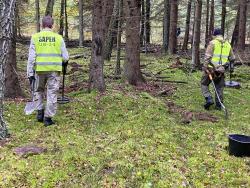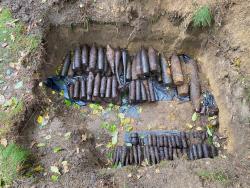 Asset Publisher
Asset Publisher
Polish forests
Poland is in the European lead, while concerning the area of all forests. They cover about 29,2 % of the country territory, and grow within the area of 9,1 million hectares. The overwhelming majority of the forests is state owned, of which almost 7,6 million hectares are managed by the State Forests National Forest Holding..
The number of Polish forest is still growing. The forestation rate of the country has increased from 21 % in 1945 to 29,2 % at the moment. Between 1995 and 2008, the forest area increased by 310 thousand ha. The basis for afforestation works is the "National Programme for Increasing the Forest Cover" (KPZL), assuming an increase of the forestation rate up to 30 % by 2020 and up to 33 % by 2050. Polish forests abound in flora, fauna and fungi. 65 % of the total number of animal species live there.
The forests grow in our country on poor soils, mainly because of the development of the agriculture in previous years. It influences the distribution of the types of the forest sites in Poland. Over 55 % of the forest areas is covered with coniferous forests. In other areas, there are forest sites, mainly the mixed ones. Their small part constitute alder and riparian forests – not more than 3 %.
In the years 1945 – 2011 the area of natural deciduous tree stands within the area of the State Forests National Forest Holding increased from 13 to 28,2 %.
Within the lowlands and uplands the most often occurring tee species is pine. It covers 64,3 % of the forest area of the State Forests National Forest Holding and 57,7 % of private and commune forests. In the mountains the predominant species is European spruce ( in the west) and European spruce with beech (in the east). Domination of pine is the result of carrying on sustainable forest management in the past. Once, the monocultures (crops or cultivations of one species) were the answer to the great demand of industry for wood. Such forests appeared to be quite fragile to climatic factors. They also were often the prey of pests' expansion.
In Polish forests, the share of other tree species, especially deciduous trees have been systematically increasing. The foresters have stepped aside from monocultures – that is why, they try to fit specific species of the forest stand to the natural stand, that would be proper for the given area. Thanks to that, in the years 1945 – 2011, the area of the deciduous tree stands within the lands of the State Forests National Forest Holding increased from 13 to 28,2 %. There occur more and more frequently the following tree species: oaks, ashes, maples, sycamore maples, elms, but also birches, beeches, alders, poplars, hornbeams, aspens, tilias and willows.
Our forests are the most often represented by the forest stands aged 40 to 80 years. The average age of the forest equals 60 years. More and more trees are of big size at the age over 80 years. Since the end of the Second World War, the forests' area has increased up to almost 1,85 million hectares.
Raport o stanie lasów w Polsce 2012
 Asset Publisher
Asset Publisher
 Asset Publisher
Asset Publisher
SAPERZY W NADLEŚNICTWIE CZARNOBÓR
SAPERZY W NADLEŚNICTWIE CZARNOBÓR
 Saperzy szukają materiałów niebezpiecznych
Saperzy szukają materiałów niebezpiecznych
 Pociski znalezione przez saperów
Pociski znalezione przez saperów
 Samochód saperski w lesie
Samochód saperski w lesie
W dniach 19 - 23.10.2020 roku na terenie Nadleśnictwa Czarnobór zrealizowano kompleksowe prace saperskie. Obszar objęty pracami to 3,55 ha zlokalizowane na terenie leśnictwa Wilcze Doły.
Prowadzone prace należą do grupy szczególnie niebezpiecznych. W związku z powyższym, mając na uwadze bezpieczeństwo osób postronnych, na okres prowadzonych prac teren został wyłączony z możliwości swobodnego przemieszczania się przez miłośników przyrody.
Obszar na którym zaplanowano wykonanie prac saperskich zakwalifikowany został jako wyjątkowo niebezpieczny z uwagi na występowanie materiałów niebezpiecznych pochodzenia wojskowego. Zadanie zrealizowane zostało przez Cywilną Firmę Saperską US 24. W pracach uczestniczyło 6 saperów podzielonych na dwu osobowe zespoły robocze. Całością prac kierował Pan Ryszard Szuba.
Prace prowadzone na terenach leśnych polegały na wykryciu oraz podjęciu wszystkich materiałów niebezpiecznych pochodzenia wojskowego. Dodatkowo do obowiązków wykonawcy należało usuniecie innych elementów niebezpiecznych pochodzenia cywilnego. Prace realizowane przez saperów wykonywane były przy wykorzystaniu profesjonalnych wykrywaczy metalu umożliwiających wykrycie elementów metalowych do głębokości 1 m. Każdy stwierdzony sygnał wymagał rozpoznania, odkopania i podjęcia potencjalnego niewybuchu z obowiązkiem przetransportowaniem go do miejsca czasowego składowania (Tymczasowy Magazyn Materiałów Wybuchowych).
Efekt wykonach prac potwierdził słuszność decyzji o oczyszczeniu saperskim wskazanego obszaru. Podjęto ponad 200 sztuk materiałów (pocisków) rozpoznanych jako niebezpieczne i stanowiące bezpośrednie zagrożenie dla życia i zdrowia ludzi. Większość ze zidentyfikowanych pocisków to materiały pochodzące z okresu powojennego stanowiące efekt ćwiczeń bojowych jakie realizowane były na tym terenie przez wojska radzieckie. Znakomita większość podjętych materiałów to pociski artyleryjskie w różnych kalibrach: 122 mm, 105 mm, 76 mm, 75 mm oraz 56 mm. Ponad to podjęto granaty moździerzowe oraz amunicję przeciwpancerną. Wartością dodaną do znalezisk niebezpiecznych było podjęcie ponad 2 ton złomu zalegającego w środowisku naturalnym.
W dniu 23.10.2020 roku, po pozytywnej weryfikacji kontrolnej, teren został powtórnie udostępniony dla miłośników obcowania z przyrodą. Wszystkie podjęte materiały niebezpieczne przejęte zostały przez Patrol Saperski Wojska Polskiego, którego zadaniem było ich przetransportowanie i unieszkodliwienie. Ostatni akt zrealizowany został na terenie poligonu drawskiego.
Wykonane prace to kolejny krok do przywracania pełnego poziomu bezpieczeństwa na terenach leśnych. Jest to bardzo ważne zarówno dla osób wypoczywających na terenach leśnych jak również tych które uczestniczą w realizacji prac w ramach prowadzonej gospodarki leśnej.
Marcin Mieczkowski - rzecznik pasowy Nadleśnictwa Czarnobór


 fot. Paweł Fabijański
fot. Paweł Fabijański
 fot. Paweł Fabijański
fot. Paweł Fabijański
 fot. Paweł Fabijański
fot. Paweł Fabijański





